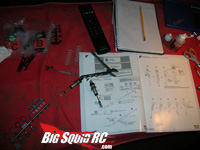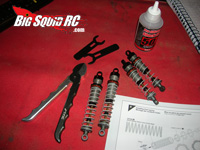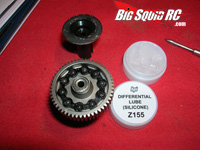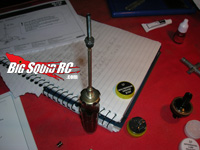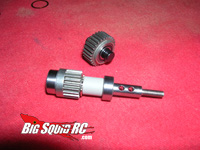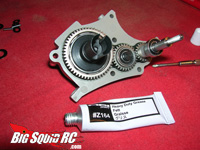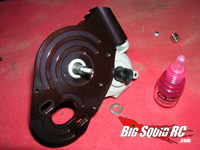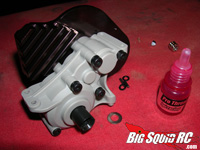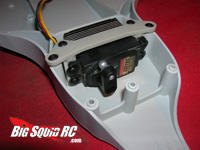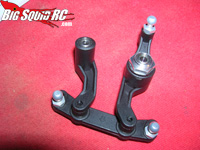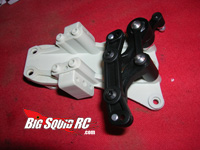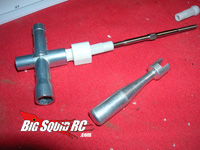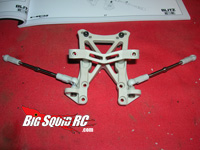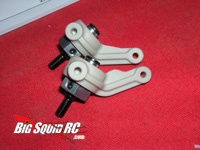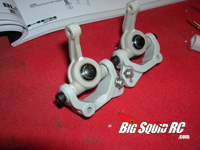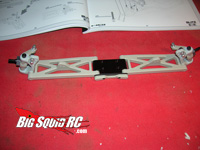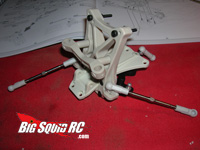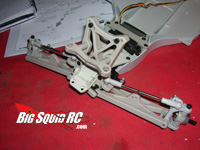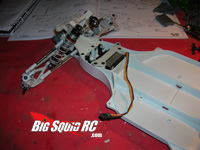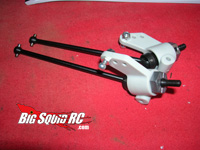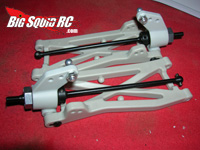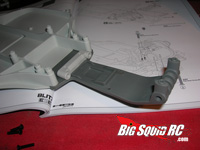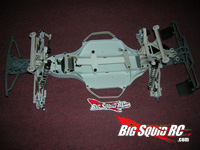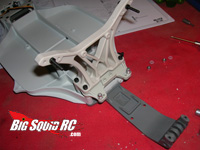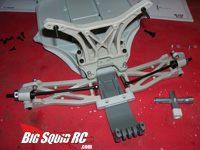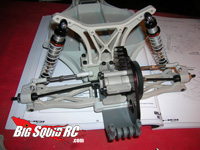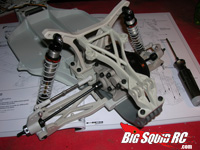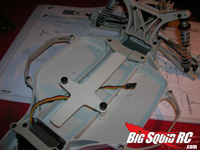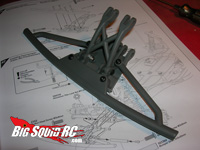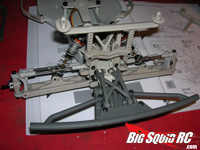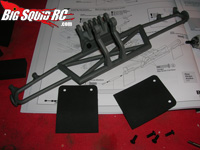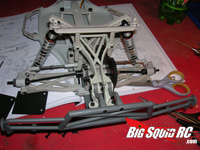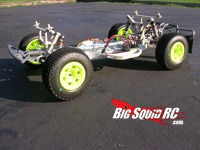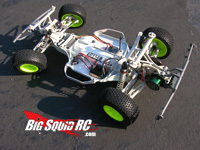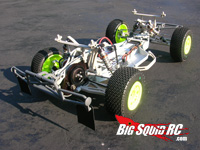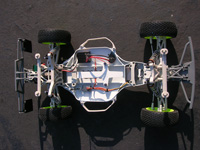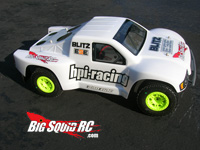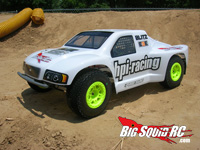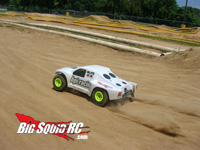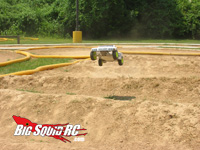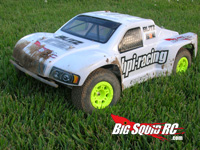HPI Blitz ESE Review and Build
From: HPI Racing
Direct Link: HPI Racing Blitz ESE
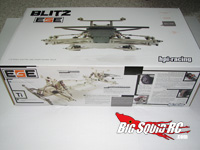 Just exactly where in my contract does it say I have to review product? I have no idea, but Brian shoved the new HPI Blitz ESE in my face and said, “Build this, test this, do something useful for a change!”.
Just exactly where in my contract does it say I have to review product? I have no idea, but Brian shoved the new HPI Blitz ESE in my face and said, “Build this, test this, do something useful for a change!”.
Ok, so here’s my “something useful” for the month. LOL
THE Build–
Yes, the Blitz ESE is a genuine kit! Meaning you don’t have to depend on the skills of some 12 year old Asian girl to determine how good your truck turns out, the quality of your truck is up to you. Personally I like kits, and think they are good for the hobby. You may not dig building kits, if so, the hobby shelves are loaded with pre-built trucks for you.
How long did it take me build? I didn’t really time it, but it took me roughly 5 movies, I watched A Clockwork Orange (bad movie to build a kit to btw!), The Usual Suspects, Wall-E, Back to the Future II, and American Gangster during the build.
HPI takes you a slightly different route during the build than other manufactures. I say this because they have your assemble the shocks and differential first, where other 2wd 10th scale kits typically have you do these last or towards the end. I actually prefer the HPI method, having the shocks and diff done before hand makes for a better flow during the build.
The first step requires opening up the first bag. This HPI build does not require you open up ten different bags just for the first step, which is a Great thing.
Build notes on the diff–
This is a very high end diff! A metal diff gear is standard, which is great for holding ridiculous brushless power. This is a ball diff, opposed to the gear diff that comes standard in the Blitz RTR. HPI gives you plenty of extra diff lube and thrush grease, more than enough for dozens of rebuilds. I really like the supplied HPI diff lube, it’s slightly heavier than what you’ll find from AE or Losi, and seems to work better. Ten 3mm Ceramic balls are used in the diff. I am not a fan of ceramic diff balls, due to them have a reputation for exploding when they get dirty, but I have not suffered any problems at all with the ESE diff. Nine 1/16th balls are used for the thrush bearing, and yes, they are a PITA to install. A 2.5mm bolt goes through the diff, plenty big, plenty strong, making it obvious HPI was a building a bomb proof ball diff. After the build, the diff felt REALLY good. When used on track, it seemed to yield a wider range of adjustment without slipping than a typical ball diff from AE or Losi. The ESE diff could be adjusted relatively loose, and yet not slip when going pinned straight forward. With the standard AE and Losi balls diffs, you have essentially have two adjustments- one that doesn’t slip, and slightly looser that does.
Build notes on the tranny–
All ball bearings, not a huge deal now days, but these bearings actually last a while. Other manufactures seem to go a little too cheap on tranny bearings now days, resulting in bearings that explode way too early in the game. The ESE comes with an extremely cool motor plate, it’s plenty thick, is nearly impossible to tweak, and helps keep motor temps down. For example on the Slash the motor mounts to plastic, that can lead to extremely high motor temps. There is only one E-clip in the entire truck, and it’s used on the top shaft of the tranny. The ESE comes stock with 3 different sizes of spurs (77, 83, and 88 tooth). If you are racing a stock 17.5 class and need a small spur, pop on the 77, or if you are running a 9,000 kv insane BL motor, HPI has you dialed with an 88, no need to run to the hobby shop looking for one. The idler and top shafts gears are both metal. HPI supplies a light grease to go on the 3 metal gears in the tranny. Some people don’t believe in using it, but in this case, please do. The HPI ESE tranny, and truck as a whole, is the quietest truck I’ve ever heard, it’s just incredible (the lube on the tranny gears helps with this). The top shaft is made out of Titanium, very strong, very light, and very trick. The ESE comes with an Uber slipper set-up. The ESE slipper works very well on track, in fact better than the stock slipper from AE. Overall, freak’n awesome tranny/slipper set-up, as good as it gets on the market.
Other build notes-
Aluminum ball studs are used throughout, which normally I’m not a big fan of. Sure Aluminum saves weight, but if you’ve ever raced a Losi on a cold day and broken off a bunch of ballstuds in their tower, you appreciate the strongest ballstuds you can get your hands on. I did NOT experience any problems with the ESE’s stock AL ballstuds, but I’m a bit weary.
Steering rack features bearings, sweet!
HPI has included nuts to secure the bottom of some of the ballstuds where needed, nice attention to detail. In fact, incredible attention to detail all over this truck.
The stock servo saver is one of the only weak points of the entire truck. It builds easy enough, and is of a fairly standard design, but perhaps the plastic it is made out of doesn’t allow for the proper amount of friction. If you adjust it normally, it’s too loose, if you adjust it all the way down, it doesn’t work at all. If you are using a cheap plastic gear servo, the saver can be adjusted to protect your gears, but steering will really suffer. If you are using one of the new age high end servos that never blow gears, just tighten it all the way down.
Everyone has a few of the HPI 4 way wrenches in their toolbox. One side of the wrench is used to slide over rod ends to tighten them. Over the years rod ends have gotten bigger and thicker, leaving the old HPI 4 way obsolete as the “D” opening had become too small. But holy cow, HPI saw the problem and included an adaptor so it works again! Huge kudos on that one.
Tie rods are typically marked so you know which way is the normal threaded end, and which has opposite threads, that way you can mount them all the same direction on your truck so it’s easier to make adjustments. On the ESE, the tie rods are just barely marked. The tie rods are Titanium though.
HPI supplies not only standard steering blocks, but also a set of in-lines. Sweet, HPI put several tuning options right in with the kit.
The front suspension arm mount is beefy, made of aluminum and looks totally trick.
The ESE comes stock with CVD’s. On the up side, they have a flat spot on each pin for the grub screw to help prevent the pin from backing out. On the downside, there is a bit of metal flash on them, making them a bit rough. Genuine MPI CVD’s would be smoother. On the downside, on the Blitz RTR version, HPI had the choice between using some cheap metal alloy or using butter as the material for their driveshafts, unfortunately they chose the softer metal alloy, as butter would have lasted longer. On the upside, the CVD’s on the ESE last MUCH longer than the RTR bones.
The body comes pre-cut and unpainted. Props on the pre-cut, this saves time.
Wheels and tires are not supplied, which is a plus. There has never been a tire supplied with a kit that worked worth a damn at my local track. Thanks to HPI for letting me spend my money on proper wheels and tires.
The instructions for the build are very good. If you are having a problem figuring out how something goes together, you need to read the manual more closely, the info you need IS in there. Look at each step very closely, and be sure to pay attention as many parts are directional and/or side dependent.
I ran into two snafus during the build. I stripped out the heads of a couple screws in the front top plate, not sure if the screw heads were a bit soft or the plastic they were being screwed into was just too hard. The rest of the build was gravy till the very last part, putting on the rear mud flaps. The ESE mud flaps are racing versions btw, made of much thinner material than those on the standard Blitz RTR. On the Blitz RTR (and certain other SC trucks) the mudflaps are thick and hard enough that if you land with the rear end first, it jerks the truck forward. The Blitz ESEs mud flaps do not do that, and work awesome on track. But when mounting them, if you tighten up the stock screws, it causes the mudflaps to be wavey and they come off easily, if you loosely tighten their mounting screws they look fine but fall off even easier. I used 4 large washers to eliminate those problems.
Driving Impression–
Jumping- The ESE jumps better, and lands better than the Blitz RTR. Geometry is the same, but the uber shocks give it the nod. The ESE typically jumps slightly nose high, which normally isn’t a big deal, or even when driving on an indoor track is no big deal, but outdoors where it’s windy, that can be a problem. Jumping a little nose high can lead to a wind gust getting under the body and blowing you over backwards. Does the ESE jump better than the Slash? Yes, by a country mile. Does it jump better than an SC10? No, it doesn’t, but, you can land a lot more sideways and not crash with the ESE than the SC10. So if you are big into scrub’n jumps (like most people are now days), the ESE might jump a bit more nose high than an SC10, but it’s tons easier to scrub with, and as a whole, jumps very well.
Corning- Most SC trucks are very loose in the rear end. The ESE is extremely planted in the rear, making it far more easy to drive aggressively on track than the offerings from other manufactures. Having that planted rear end does come at a price, as the Blitz ESE is not an aggressive turner. The ESE prefers flowing lines over point and shoot. Luckily, flowing lines is nearly always the fastest way around a track. But, if you race on a small track, or one with lots of tight 180’s, the SC10 will be turning under you. There are two reasons the Blitz can’t/won’t cut the tightest corners- 1. it’s limited in steering travel, and 2. the Ackerman isn’t optimal for tight corners. You can fix #1 fairly easily by removing some material on the steering blocks for more throw, we did this mod and have a couple pictures to show you what material to remove. For #2, when you throw the front tires to maximum left or right, the inside tire is at the exact same angle as the outside tire. On a tight corner, the inside tire needs to turn a tighter arch than the outside for maximum cornering, but the ESE isn’t set up (with the book set-up anyways) to do this. A bit more Ackerman would do the ESE a world of good on the tight corners. Overall though, the ESE has incredible corner bite and carriers class leading speed in the corners. While I may have listed some downsides, the ESE is the king of the class for corner speed, and because it doesn’t have any over steer, it’s also easier to drive for newbies.
Bumps/Whoops- The Blitz ESE is more stable through the rough stuff on track than an SC10 or Slash. A long section of bumps or chop that would put an SC10 into a tank slapper is much more easily handled by the ESE. And if you do get out of shape in the rough, the ESE usually gives you enough warning to where you can make corrections to save it from rolling over.
Bashing- BigSquid is a bashing site, and I did put in plenty of bash time with the ESE. The standard Blitz RTR is the class leader, hands down, in toughness. Now the Traxxas fan boys might say how tough their Slashs are, but the Blitz never blows out spurs, and the shock caps never come off, AND the Blitz can be run in demo derbys and jumped off the roof of your house with zero breakage. The Slash is one tough customer for sure, but yes, the Blitz RTR is even tougher. Needless to say, the ESE seems to be just as tough as the RTR version. I had absolutely no breakage on the Blitz ESE, and yes, I did all the normal stupid stuff with it, the kinds of stupid stuff you only due to cars you don’t own. 🙂 Now, as far as driving while bashing, I think the ESE might very well have the field covered as well. If you do a lot of parking lot bashing, the ESE won’t be on it’s lid after every high speed corner like a Slash. The one downside is if you do a lot of bashing in grass, there the Slash has the edge with its greater ground clearance. The ESE eats race tracks for breakfast, and for that ability it pays the price in not being as capable on grass.
Overall–
The white color of all of the plastic is a love or hate thing. I dig the white plastic, it’s sorta retro, looks trick, and stands out in a crowd. Pretty trick that each different color of the plastic means a different stiffness.
People always ask the question, “What would you change?”. Well, I wouldn’t change much, I’d like to see a better working servo saver, and a bit more steering.
Traxxas and AE both have fairly active on-line communities to get more info and tuning tips about their SC trucks, but HPI has one better. You can head over to RcShortCourse.com and communicate directly to Erik Shauver, the person that designed the Blitz. Nothing like getting answers and set-up tips from the person that designed the truck.
To boil it all down- the Blitz ESE is a very well done esoteric racing version of the Blitz RTR. The ESE comes with all the trick parts you would want, and it gets around a track better than the offerings from Associated and Traxxas. Oh and, yes, it’s the toughest truck in the class. It’s obvious a lot of time, effort and passion went into the ESE from it’s designers, the “above and beyond” attention to detail is easy to see. Is it perfect? No, nothing is, but it is the best truck in the class.
YOUR Cub Reporter
SUMMARY Time To Bash – 7.5/10 – It’s a KIT. Take your time, do it right! Workability – 9.0/10 – Just like the original, great to work on Car Show Rating – 10.0/10 – I dig the retro and different look! It turns heads! Bash-A-Bility – 9.5/10 – Bashing the Blitz ESE has been amazing. Nothing Broken! Big Squid Rating – 9.5/10 – Tentacles.. This is the best short course truck there is right now. HPI Nailed it!
Click here to see the HPI Bltiz ESE un-boxing pictures we posted.
Click here read the original HPI Bltiz review we did a while back.

